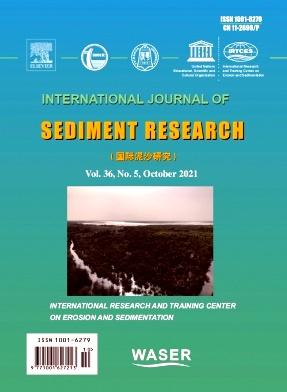Soil erosion risk assessment of the Lakhmess watershed (northwestern Tunisia) via the SEAGIS model: Inferred prioritization of risky sub-watersheds
IF 3.7
2区 环境科学与生态学
Q2 ENVIRONMENTAL SCIENCES
引用次数: 0
Abstract
Water erosion in Tunisian semi-arid regions causes harmful effects by silting reservoirs and reducing agricultural lands and soil fertility. Several factors are involved in the erosion process: rain erosivity, soil fragility, and degraded land cover on steep slopes associated with the intensification of inappropriate human practices. Thus, identifying erosion vulnerable sub-watersheds based on the assessed soil loss rate is very important to apply suitable conservation measures. The current research aimed to prioritize risky areas in the Lakhmess watershed, north-west Tunisia via the Soil Erosion Assessment using Geographical Information System (SEAGIS) model. To prioritize sub-watersheds vulnerable to soil erosion and sediment yield, the Lakhmess watershed, covering an area of 162 km2, was divided into 16 sub-watersheds (L1–L16), according to the hydrographic network. Then, the mean annual soil erosion rate and the mean annual sediment yield in the watershed were estimated by integrating the Revised Universal Soil Loss Equation (RUSLE) and the Sediment Delivery Ratio (SDR) in the SEAGIS model and their spatial distribution was determined. The obtained results indicate that the estimated average annual soil erosion rate is 4.2 t/ha/y and the annual sediment yield is 2.6 t/ha/y. Maner's SDR model was selected as the best model for estimating SY, with standard error, standard deviation, and coefficient of variation values of 0.75%, 0.01, and 0.45%, respectively. The prioritization of the Lakhmess sub-watersheds based on the estimated soil loss rate reveals that among the 16 sub-watersheds, three sub-watersheds (L10, L12, and L15) were identified as being in a very high priority soil erosion class. The high soil erosion rate and sediment yield in these sub-watersheds is explained by the steep slope and a high rainfall erosivity factor. Six sub-watersheds (L2, L4, L5, L6, L7, and L16) were found to belong to a very low priority soil erosion class, as they are characterized by a very gentle slope, which appears to be an extremely determining factor. These findings constitute a basis for decision makers to plan effective conservation measures to conserve agricultural lands, soil, and water resources in northwestern Tunisia.
通过 SEAGIS 模型对 Lakhmess 流域(突尼斯西北部)进行土壤侵蚀风险评估:推断风险子流域的优先次序
突尼斯半干旱地区的水土流失造成水库淤塞、农田减少和土壤肥力下降等有害影响。水土流失过程涉及多个因素:雨水的侵蚀性、土壤的脆弱性以及与人类不当行为加剧有关的陡坡土地覆盖退化。因此,根据评估的土壤流失率确定易受侵蚀的次级流域对于采取适当的保护措施非常重要。目前的研究旨在通过使用地理信息系统(SEAGIS)模型进行土壤侵蚀评估,确定突尼斯西北部拉赫梅斯流域风险区域的优先次序。为了确定易受土壤侵蚀和泥沙产生影响的子流域的优先次序,根据水文地理网络,将面积为 162 千米的拉赫梅斯流域划分为 16 个子流域(L1-L16)。然后,利用 SEAGIS 模型中的修订通用土壤流失方程(RUSLE)和泥沙输移比(SDR),估算了流域的年平均土壤侵蚀率和年平均泥沙输移量,并确定了它们的空间分布。结果表明,估计年平均土壤侵蚀率为 4.2 吨/公顷/年,年泥沙产量为 2.6 吨/公顷/年。Maner 的 SDR 模型被选为估算 SY 的最佳模型,其标准误差、标准偏差和变异系数值分别为 0.75%、0.01 和 0.45%。根据估算的土壤流失率对拉克梅斯分流域进行优先级排序后发现,在 16 个分流域中,有 3 个分流域(L10、L12 和 L15)被确定为土壤侵蚀优先级极高的流域。这些次级流域的土壤侵蚀率和泥沙产量较高的原因是坡度陡峭和降雨侵蚀系数较高。六个次级流域(L2、L4、L5、L6、L7 和 L16)被认定为属于极低优先级的土壤侵蚀等级,因为它们的特点是坡度非常平缓,这似乎是一个极其重要的决定因素。这些发现为决策者规划有效的保护措施提供了依据,以保护突尼斯西北部的农田、土壤和水资源。
本文章由计算机程序翻译,如有差异,请以英文原文为准。
求助全文
约1分钟内获得全文
求助全文
来源期刊
CiteScore
6.90
自引率
5.60%
发文量
88
审稿时长
74 days
期刊介绍:
International Journal of Sediment Research, the Official Journal of The International Research and Training Center on Erosion and Sedimentation and The World Association for Sedimentation and Erosion Research, publishes scientific and technical papers on all aspects of erosion and sedimentation interpreted in its widest sense.
The subject matter is to include not only the mechanics of sediment transport and fluvial processes, but also what is related to geography, geomorphology, soil erosion, watershed management, sedimentology, environmental and ecological impacts of sedimentation, social and economical effects of sedimentation and its assessment, etc. Special attention is paid to engineering problems related to sedimentation and erosion.

 求助内容:
求助内容: 应助结果提醒方式:
应助结果提醒方式:


